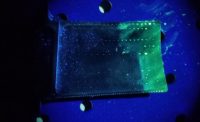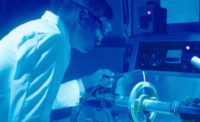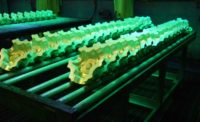Although there seem to have been several high-profile quality control issues in the aerospace industry in recent years—such as several large recalls from high-profile airplane manufacturers—quality control in the aerospace arena is improving.
“Things are being found that weren’t noticed in the past,” says Greg Burdick, national sales manager at industrial borescope company Richard Wolf. “These issues may have been overlooked in the past, but due to these newer types of inspections and measurements, they’ve come to the surface and they’ve raised the flag.”
This is in large help to nondestructive testing (NDT). And while the technology itself –Computed Tomography (CT) scanning, digital X-ray technology and ultraviolet inspection (UV) –may not strike us as the newest, what has changed is the widespread demand for it. More and more aerospace suppliers are adopting NDT, or they’re making advances in how they use it.
“For example, UV inspection has been around for many years, but we’re now seeing more and more people who want to do it with smaller diameter borescopes,” Burdick notes.
Richard Wolf has been able to meet airline demand with borescope kits that are used for inspection of gas turbine engines while on-wing. In addition, it supplies the blending borescope, which allows professionals to do on-wing repairs of gas turbine engines when they have minor damages on the edges of the blades.
“Basically that allows the airline or the user to make these minor repairs while the engine is on a wing, as opposed to removing the engine from the aircraft, repairing it then putting it back on the wing,” Burdick explains.
This technology is a whopping 10 years old—not new, per se. But the trend toward embracing it is becoming a vertical one.
“A lot of companies are being directed to do more inspections,” Burdick says. “Say the machine shop that is manufacturing the component, or the casting house that’s doing the casting--the end user, be it Boeing, GE, whoever it may be-- they’re putting more and more pressure on the tier-one supplier to do a total quality inspection of the component before it’s received at the end user’s dock. We’re seeing more and more people using remote visual inspection, X-ray, and they also now using more UV inspection utilizing borescopes.”
The swiftly adoption of NDT—especially digital X-ray and CT scanning—is becoming prominent among aerospace suppliers.
“On a daily basis we are talking to and working with many aerospace companies who either have evolved in this direction and are expanding programs or are looking to learn and move in this direction,” says Ben Connors, manager, inspection services at North Star Imaging (Rogers, MN).
“These companies are often airframe and power plant OEMs, and most of their high-end suppliers utilize this technology on a daily basis to find defects.”
Part of the reason why these technologies are so prevalent now are their sheer efficiency. Kevin Legacy, Manager: Computed Tomography & Engineering at Carl Zeiss Industrial Metrology (Brighton, MI), says that CT scanning takes a fraction of the time that it used to.
“Rather than our CT machines taking hours to scan an aerospace component, let’s say a jet engine blade, that’s down to less than an hour,” he says.
Keeping Pace, Destructively
As long as NDT exists, so will destructive testing.
“Destructive testing has a place as well as NDT,” Legacy explains. “This type of testing is not going to go away for a long time. The act today of cutting a part, polishing it, perhaps milling it; putting it under a microscope so you can really see the brain and substructure --that’s not going to go away anytime soon.”
These technologies—and their coexisting labs--will continue to work in tandem, Legacy says.”A certain product might be defined as requiring a destructive series of tests as well as a nondestructive series of tests in order to go through a program of validation,” he notes. “I don’t see that changing anytime soon.”
Out With the Old
As computed radiography (CR), CT and digital radiography (DR) maintain their strongholds, a different nondestructive test method—photogrammetry—is being phased out. Whereas digital technology offers much more in the way of contrast sensitivity—for example, it might exhibit 65,000 shades of gray where film reveals 125—film limits users to what the human eyes can see.
“There will probably always be areas where film is used, but it’s not growing the way DR and CT are,” says Connors. “We continuously talk to people in new markets. They want a tool to do something that film cannot do.”





